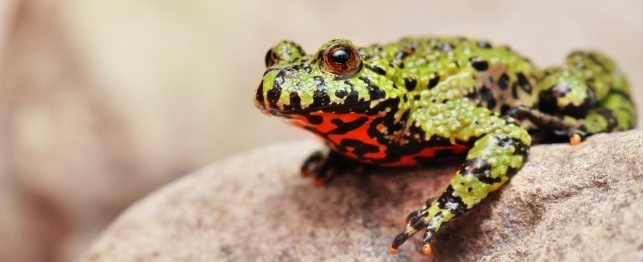

Reptiles
Fire-bellied toads make attractive, undemanding, lively, long-lived pets – but they are a species that should be kept only with other fire-bellies.
When sheltered among the plants of the vivarium these small pop-eyed pond denizens sit nearly unseen, camouflaged by their mottled black, green, and gray backs. But it's the underside of these frogs that makes them so popular: a boldly patterned bright orange belly with contrasting black reticulations that signal that fire-belly toads release toxic skin secretions that can sicken or kill animals that might try to harm them.
Fire-bellied toads are members of the family Discoglassidae, which must catch prey in their mouths rather than with their tongues. They are in the genus Bombina, which consists of six different species. The three species usually found in the pet market all take essentially the same uncomplicated care: clean water, a haul-out area, live food and a little light.
When startled, fire-bellies arch their heads, thrust back their forearms, and stretch their hindlegs over their backs displaying the colors of their abdomen. This is known as the "unken (German for boat) reflex" referring to the bowed shape of the frog's arched belly.
The colors that are displayed are called aposematic colors because of the warning message they send.
Housing for the fire-bellied toads can either be aquatic or semi-aquatic. A 20-gallon aquatic tank will give you room for some half-dozen frogs. Set up the tank as you would an ordinary fish tank with a gravel or river rock bottom and a filtration system to keep the water clean and well-oxygenated. Use only water that has been dechlorinated to protect the frogs' permeable skin. Change a quarter of the water every couple of weeks. Install submerged logs, floating plants or a plastic lily pad for a resting/haul-out area. Plants also provide homes for tiny snails, small fish and aquatic insects that the frogs will eat. Also provide a spot to tip in a few small crickets at feeding time.
A semi-aquatic tank will give the toads more opportunity to explore and give you an opportunity to create an inviting micro-environment with lush plantings, craggy logs, mosses and perhaps a waterfall. The circulating pump used for the waterfall can be used in conjunction with a filter, but water changes will still be needed at least every two weeks. Maintain the tank at a temperature between 78 degrees Fahrenheit in the summer to 68 F in the winter.
These frogs are insectivorous and need live food. They'll gobble up small crickets set loose on the floating plant surfaces, or on the land area of the semi-aquatic tank. Wait until the first few are consumed before adding more. Once a week, just before you add them to the tank, dust the insects with a calcium/vitamin supplement. If you raise your own crickets, feed them on a commercial cricket "gut-loading" diet before giving them to your frogs. These "stuffed" crickets further benefit the fire-bellied toad that eats them.
Other food can include wingless fruit flies or house flies (toadlets will need the smaller fruit flies), small moths, moth larvae, small mealworms and guppies. Remember that once a week you'll need to dust the food items with vitamin/mineral supplement before you place them with the frogs. Offer the earthworms at the end of a broom straw. Earthworms are high in calcium, which helps avoid metabolic bone disease.
These little pop-eyed denizens will soon learn to equate the approach of their owner with food, and will swim eagerly to the front of their tank, chins lifted in anticipation. They should live from 10 to 14, even 20 years and unlike some other herptiles, they'll never outgrow their tank.
Copyright © 2005-2016 Pet Information All Rights Reserved
Contact us: www162date@outlook.com